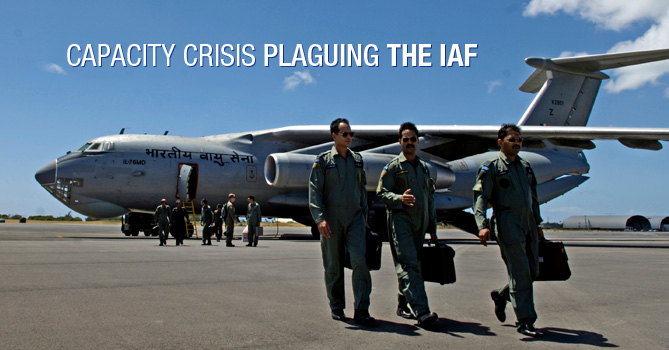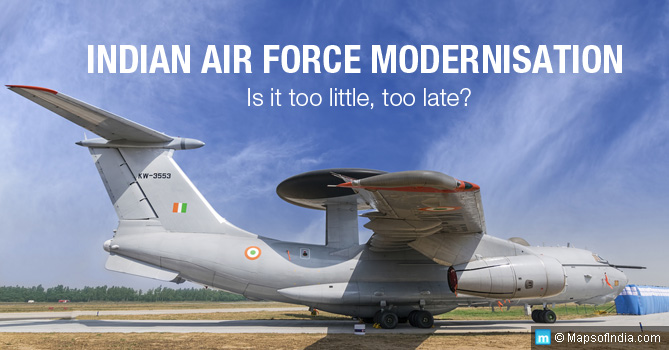Nabha Sparsham Deeptam – Touching the Skies with Glory
That is the elevated motto of the Indian Air Force, the sentinels of the Indian skies, the pride of our nation. Those who witnessed the IAF’s display of combat and firepower might at the Iron Fist Exercise 2016 came away in complete awe of the rigorous discipline, immense hard work, and the resolute determination of these men in blue. The IAF has remained strong and unflinching in the face of any external aggression. But the organization may be battling a much bigger enemy back home – an acute shortage in manpower. A looming capacity crisis is a grave concern both for the IAF and for the nation.
Shortage of Pilots
The realization that the IAF is undergoing a massive capacity crisis is hardly a new one. Even as far back as 2010, the then Chief of Air Staff, Air Chief Marshal PV Naik had spoken of a shortage of about 300-400 pilots and had promised to fill in the vacancies by 2012.
In 2015, the 35-member Standing Committee on Defence sounded the alarm bells. The shortage of both pilots and planes is now reaching critical levels, said the committee to the MoD. The committee’s report was categorical, “Drawdown has already begun and, by 2022, air force will have around just 25 squadrons, thereby losing even the slight edge over rival neighbouring nations“.
Guarding Both Fronts
The gravity of the capacity crisis faced by the Indian Air Force can be gauged by a recent statement issued by the Vice Chief of Air Staff, Air Marshal BS Dhanoa who said that the IAF was not adequately equipped to fully execute an air campaign in the event of a two front war – a war that may test India’s air strength in both the eastern and western theatres. Currently, the two main borders that the IAF is guarding are the western frontier with Pakistan and the north-eastern frontier with China. The central and southern operations are also severely affected by the shortage in capacity. Addressing a press conference, Air Marshal Dhanoa said, “Our numbers are not adequate to fully execute an air campaign in a two-front scenario. Probability of a two-front scenario is an appreciation which you need to do. But, are the numbers adequate? No. The squadrons are winding down.” The IAF has an authorised strength of 42 squadrons across the nation. With the MiGs being in the phase out process, only 33 of the 42 are currently operational. The top brass of the Air Force have conveyed their concerns to the Ministry of Defence.
Keeping Up With Ambitions
Since 2014, the focus of the Indian government has shifted to strengthening the eastern and north-eastern frontiers, traditionally neglected in comparison to the rest of the country. INR 1000 crore was sanctioned for the development of seven Advanced Landing Grounds (ALGs) in Arunachal Pradesh. Of these two ALGs at Ziro and Along were upgraded and inaugurated in March 2016 and three more are likely to be up and running within three months. While the infrastructure is already in place, the manpower and the machines needed to strengthen these regions are still lacking. For now, these ALGs shall be operating on the borrowed strength from various Air Force Stations in Assam. To add to our concerns, the military strength across the border is simply put, enviable. To derive any real comfort from the presence of our brave men in blue in these parts it is imperative that we provide them with the numbers and the machines to keep operations running smoothly.
Balance Of Power
India needs to work on building its capacity and strength at the earliest. Other Asian countries, especially, our neighbouring nations seem to be in a race to modernize their air fleet and are making great technological advances in air warfare. Pakistan is likely to receive 8 more F-16 Fighting Falcon (fighter places) from the US and is procuring JF-17 Thunder fighter jets in large numbers. The JF-17 Thunder has been jointly developed by Aviation Industry Corporation of China (AVIC) and Pakistan Aeronautical Complex (PAC). Tejas, India’s indigenously manufactured light combat aircraft is quite capable of rivaling its capabilities but the delays in its development and supply is still a matter of concern. Over the past two years, Pakistan has also upgraded 14 of its existing F-16 Fighting Falcon aircrafts. China has kept its J-20 stealth fighter a secret and its purported capabilities could cause much worry for India.
China and Pakistan together have a combined strength of 750 advanced multirole fighters against the 450 fighters in the IAF at the moment. By 2025, China alone is likely to increase its aircraft strength to about 400. Strengthening India’s procurement mechanism and the Make in India environment are key to boost our own capabilities and maintaining the balance of power in southern Asia.
Man and the Machine
Apart from the manpower crunch, IAF is also very low on its aircraft to pilot ratio. As of 2015, the aircraft to pilot ratio of the IAF was 1:0.81 while the sanctioned ratio for fighter planes is 1:2.5, transport aircrafts is at 1:1.5 and other helicopters is 1.1 (while the US has a 2:1 pilot to cockpit ratio and Pakistan has a 2.5:1 ratio). Despite robust plans to induct Tejas and other Medium Multi-Role Combat (MMRC) Aircrafts it is likely that the IAF will increase its squadron strengths to 42 only by the end of 2032. And that, if all procurement and manufacturing plans go smoothly. Meanwhile, a report by Ashley Tellis, an expert on defence and security systems from the US says that “many of its (IAF’s) frontline aircrafts are obsolete”. Adding to the IAF’s woes, it looks likely that some 272 Su-30s (the current workhorse) may have to be fielded due to low serviceability.
As things stand, the fate of the 126 MMRCAs that were initially slotted for procurement, seems unclear. PM Modi’s Paris visit has assured us of only 36 new Rafale jets. What India needs at the moment is a realistic look at our indigenous capabilities and work overtime to plug the gap between our requirement and availability. Apart from this, the government with the IAF must increase investment in MMCRA, electronic capabilities, and newer munition systems. At the same time, the IAF needs to work out a comprehensive strategy to increase its manpower. Increasing brand awareness and social communication, offering high-level training and career development opportunities, and striking a chord with the younger generations is becoming increasingly important.






